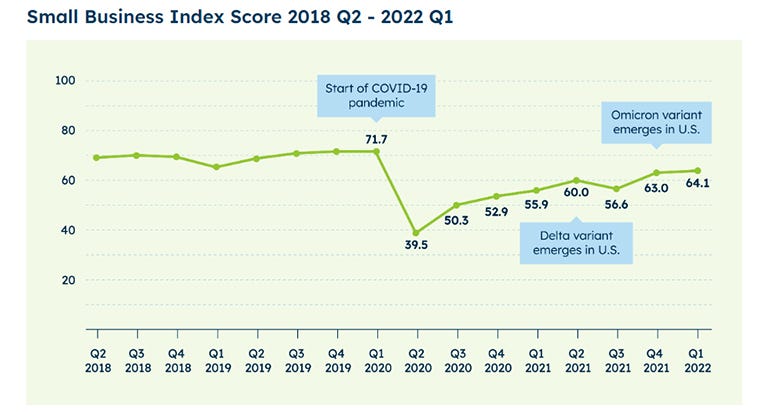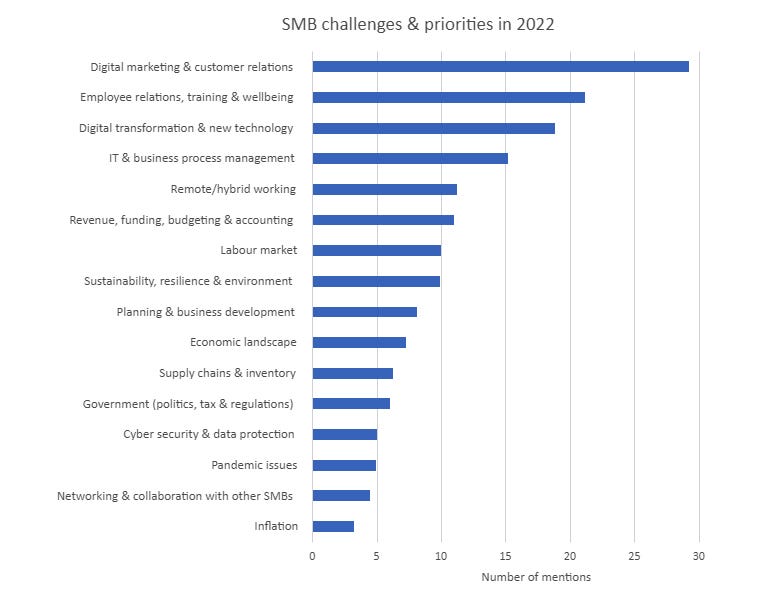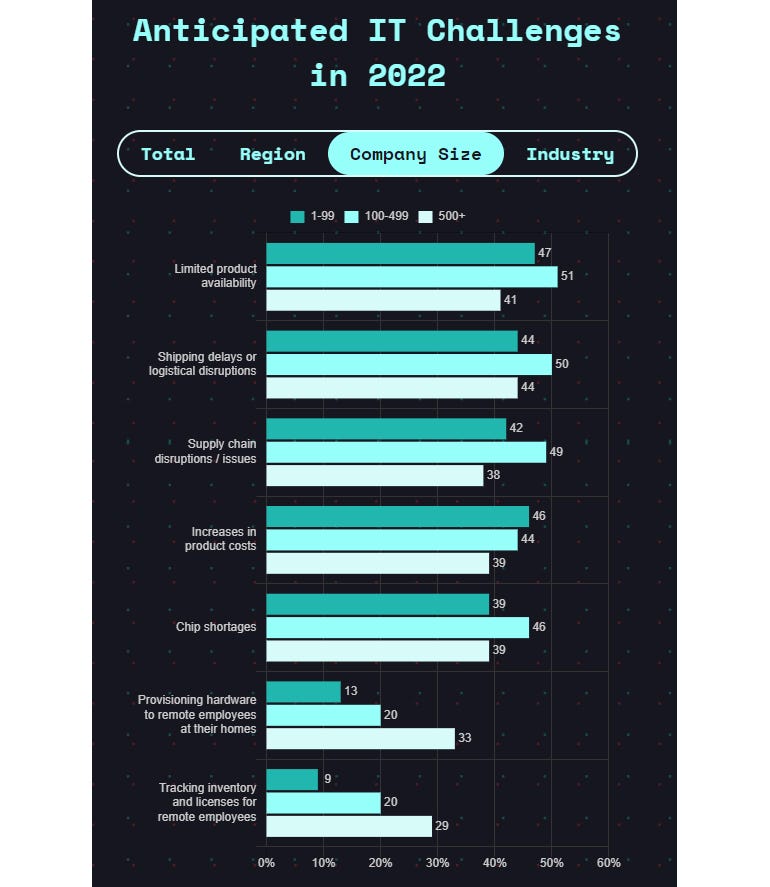With nearly half of 2022 behind us, the challenges facing small and medium-sized enterprises (SMEs) remain significant. The Covid-19 pandemic is still with us, causing continued pressure on income and cash reserves, upheavals in the labor market and disruptions in supply chains.
Energy prices, already rising due to strong demand as economies began to emerge from the 2020/21 recession, were further pushed higher by the war in Ukraine, leading to widespread rising inflation .
And these difficult times are not going away anytime soon.
Macroeconomic trends
In December 2021, the OECD noted that “production rates in most OECD countries are now higher than at the end of 2019 to return to their pre-pandemic levels. But weak economies, especially those in countries with low vaccination rates, risk being left behind.”

Chart: OECD.
Inflation, which should have peaked at the end of 2021, is expected to increase a further 2.47% worldwide this year. This is due to the shock in the financial and commodity markets caused by Russia’s invasion of Ukraine. The impact on global GDP over the same period is expected to be 1.08%.
Small Business Health and Trust
How do these macro trends play out in small businesses?
In the United States, the health of SMEs (i.e. companies with less than 500 employees that are not sole proprietorships) is monitored quarterly by the American Chamber of Commerce/Met Life with the “Small Business Index”. Its latest score, based on a survey conducted between January 14 and 26 (i.e. before Russia invaded Ukraine), was 64.1 – the highest level since January. start of the pandemic.

Chart: US Chamber of Commerce/Met Life.
Inflation has topped the challenges facing SMEs in recent quarters, followed by supply chain issues. Issues related to Covid-19 also remain relevant. Meanwhile, concerns about employee well-being and morale have steadily risen, while revenues have become less of an issue as the US economy emerges from recession.
It will be interesting to see if the picture changes significantly in the second quarter, when the effect of the war in Ukraine is felt, and if the 51% of American small business owners who thought in the first quarter that the small business climate would return to normal within six months to a year have changed.
Challenges and priorities for SMEs in 2022
To get a sense of the specific concerns small businesses will face in 2022, we reviewed more than two dozen surveys and forward-looking articles published over the past year and recorded mentions of different issues and areas. . Here is the resulting table:

Graphic: ZDNet.
The five main issues – digital marketing and customer relations; employee experience, training and well-being; digital transformation and new technologies; IT and process management; and teleworking and hybrid working – are all related, to some extent, to the experience of the pandemic.
Digital Marketing and Customer Relations
During times of lockdowns, the focus of attracting new customers and satisfying existing customers has inevitably shifted to online channels.
But it’s not enough to build a website with a functional e-commerce solution and then hope that customers will come: you have to work on your SEO, and attract and convert new prospects through e-mailing campaigns and social media.
For this, companies are increasingly using video and influencers of all kinds. And once customers have been acquired, it is clearly essential to have effective customer relationship management (CRM) systems in place in order to be able to provide a satisfying and loyal experience.
Employee experience, training and well-being
In the world before (the pandemic), we didn’t care so much about the employee experience. But two years of widespread changes to working conditions and practices have changed the game and brought to light concerns about burnout, workers’ mental health and work-life balance, among others.
Today, employers not only need to rethink how they manage employee workflows and monitor their performance, but also how they communicate effectively with them. And thus find new ways to train, coach and mentor them. Especially when they are at a distance.
A company that fails in this area will find it difficult to retain its employees. And SMEs that do not have staff dedicated to human resources must be particularly attentive to this parameter.
Digital transformation and new technologies
Digital transformation and the adoption of new technologies is an important focus for SMEs, as it can put them in a better position to overcome difficult economic conditions and gain an advantage over their competitors.
Cloud-related technologies such as Software-as-a-Service (SaaS) applications – especially those aimed at specific vertical markets – offer clear advantages in terms of shifting capital expenditures to operational expenditures, by outsourcing deployment and maintenance of the underlying technology.
This should enable companies to focus on adding value through agile development of bespoke products and services, and transforming online experiences using new technologies like augmented reality (AR) and virtual reality ( VR), or machine learning (ML) and artificial intelligence (AI).
IT and process management
Driving a company’s digital transformation isn’t just about adopting cutting-edge technology for new projects: often it’s centered around the need to increase the efficiency of existing systems and processes, and that will continue to grow. be a priority for SMEs.
Knowing how to use siled data (structured and unstructured) held in the IT estate can, for example, unlock business value.
Implementing solutions that make an SME look like a large enterprise – adopting an interactive voice response system, for example – is also an important success factor, as is increased automation, streamlining of development and maintaining websites, moving to e-commerce, and speeding up fulfillment and delivery. Less glamorous than the adoption of AR/VR and AI, perhaps, but just as important.
Telecommuting and hybrid work
One of the most profound changes wrought by the Covid-19 pandemic will likely be a lasting shift towards telecommuting and hybrid working, and the disappearance of the traditional office as the primary workplace for many employees.
Despite predictable resistance from more conservative circles, it appears companies are adapting to the shifting employee expectations generated by the 2020 and 2021 lockdowns: many employees have proven they can work productively since their home, or rarely going to the office. And they have no desire to go back.
In the future, work will likely fall on a continuum from fully remote to fully in-office to hybrid working, with the balance depending on the role of the employee, the industry in which their business operates and personal choice. SMBs will need to ensure productivity, communication and security technologies are in place to serve remote and hybrid workers, as the demand for flexible working is not going to go away, and latecomers are likely to find it difficult to retain staff. and to recruit.
Other priorities
No surprise among the other challenges and priorities listed above, although inflation and supply chain concerns are likely to be stronger now than they were when surveys and studies used to compile them have been published (mainly before the conflict in Ukraine). It is also nice to see that the heading “Sustainability, resilience and environment” appears in the middle of the table.
The state of IT in 2022
To analyze the current state of the IT field, SpiceWorks Ziff Davis has released the 2022 edition of its annual report on the subject. Conducted in July 2021 among 1,145 IT buyers from organizations in North America (57%) and Europe (43%), it is clearly biased towards SMBs, with 35% of companies having 1-99 employees and 32% from 100 to 499 employees.
Prior to the war in Ukraine and the recent rise in inflation, there were “reasons for optimism, following a general decline in tech spending growth in 2021,” the report says, while noting that “the pandemic of Covid-19 will continue to have a noticeable impact on the information technology sector – either directly, through supply chain issues, or indirectly, through the legacy of rising security levels. flexibility of teleworking”.
The challenges planned for 2022, broken down by company size, looked like this in July last year:

Graphic: Spiceworks Ziff Davis.
IT buyers, particularly in medium-sized enterprises (100-499 employees), were most concerned about limited product availability, shipping delays or logistical disruptions, supply chain issues, increased cost of products and shortage of chips. Provisioning and support for remote workers was lower on the list (perhaps because those issues were largely resolved in 2020).
Outlook
As economies began to recover from the recession due to the pandemic, the war in Ukraine and rising inflation created new headwinds through which SMEs must navigate.
SME health and confidence indices have generally increased between 2021 and the first quarter of 2022, but recent political and economic shocks may well be about to put a damper on this optimism.
The main concerns of SMEs in the year 2021 and in anticipation – before the war in Ukraine – of the year 2022 include digital marketing and CRM, employee relations, digital transformation, IT and management of process, as well as telecommuting and hybrid work.
At the same time, IT product buyers anticipate challenges related to product availability, shipping delays, supply chain issues, rising product costs and chip shortages.
Source: ZDNet.com
